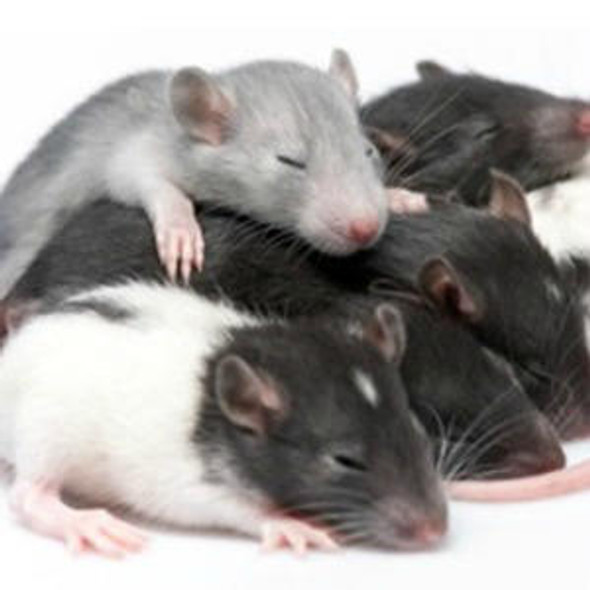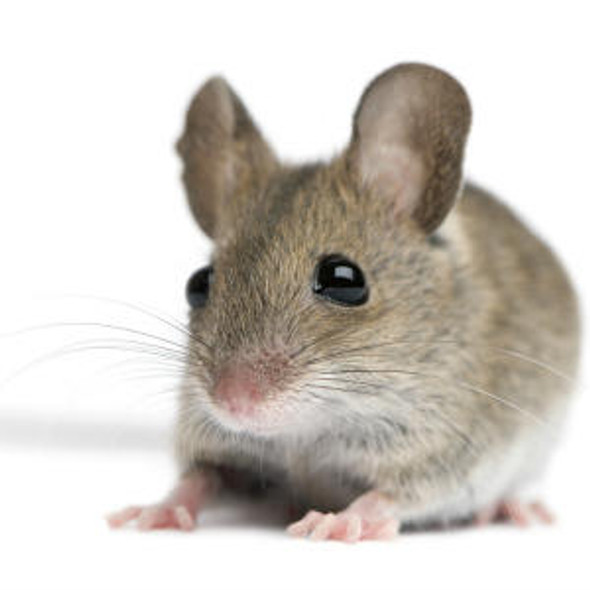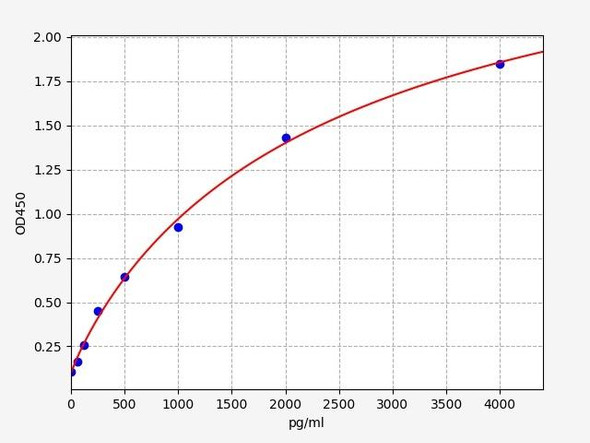Rat SMAD2 ELISA Kit
- SKU:
- RTFI00486
- Product Type:
- ELISA Kit
- Size:
- 96 Assays
- Uniprot:
- O70436
- Sensitivity:
- 0.375ng/ml
- Range:
- 0.625-40ng/ml
- ELISA Type:
- Sandwich ELISA, Double Antibody
- Synonyms:
- Smad2, JV18, MADH2, MADR2, JV18-1, hMAD-2, hSMAD2, SMAD family member 2, SMAD 2, Smad2, JV18-1, Mad-related protein 2, hMAD-2
- Reactivity:
- Rat
Description
| Product Name: | Rat Smad2 (Mothers against decapentaplegic homolog 2) ELISA Kit |
| Product Code: | RTFI00486 |
| Size: | 96 Assays |
| Target: | Rat Smad2 |
| Alias: | Smad2, JV18, MADH2, MADR2, JV18-1, hMAD-2, hSMAD2, SMAD family member 2, SMAD 2, Smad2, JV18-1, Mad-related protein 2, hMAD-2 |
| Reactivity: | Rat |
| Detection Method: | Sandwich ELISA, Double Antibody |
| Sensitivity: | 0.375ng/ml |
| Range: | 0.625-40ng/ml |
| Storage: | 4°C for 6 months |
| Note: | For Research Use Only |
| Recovery: | Matrices listed below were spiked with certain level of Rat Smad2 and the recovery rates were calculated by comparing the measured value to the expected amount of Rat Smad2 in samples. | ||||||||||||||||
| |||||||||||||||||
| Linearity: | The linearity of the kit was assayed by testing samples spiked with appropriate concentration of Rat Smad2 and their serial dilutions. The results were demonstrated by the percentage of calculated concentration to the expected. | ||||||||||||||||
| |||||||||||||||||
| Intra-Assay: | CV <8% | ||||||||||||||||
| Inter-Assay: | CV <10% |
| Uniprot: | O70436 |
| UniProt Protein Function: | SMAD2: ubiquitously expressed transcription factor phosphorylated and activated by TGF-beta receptor-type kinases. Participates in a wide range of critical processes including morphogenesis, cell-fate determination, proliferation, differentiation and apoptosis. Phosphorylated Smads dimerize with collaborating Smad4 and are translocated into the nucleus, where the transcription of target genes is stimulated. Two alternatively spliced isoforms have been described. |
| UniProt Protein Details: | Protein type:Transcription factor; DNA-binding Chromosomal Location of Human Ortholog: 18q21.1 Cellular Component: cytoplasm; cytosol; nuclear chromatin; nucleoplasm; nucleus; transcription factor complex Molecular Function:chromatin binding; DNA binding; double-stranded DNA binding; metal ion binding; phosphatase binding; protein binding; protein heterodimerization activity; protein homodimerization activity; SMAD binding; transcription activator binding; transcription factor activity; transcription factor binding; transforming growth factor beta receptor binding; transforming growth factor beta receptor, pathway-specific cytoplasmic mediator activity; ubiquitin protein ligase binding Biological Process: activin receptor signaling pathway; anterior/posterior pattern formation; cell fate commitment; common-partner SMAD protein phosphorylation; embryonic cranial skeleton morphogenesis; embryonic foregut morphogenesis; endoderm formation; gastrulation; gene expression; in utero embryonic development; insulin secretion; lung development; mesoderm formation; negative regulation of cell proliferation; negative regulation of transcription from RNA polymerase II promoter; negative regulation of transcription, DNA-dependent; negative regulation of transforming growth factor beta receptor signaling pathway; organ growth; palate development; pancreas development; paraxial mesoderm morphogenesis; pericardium development; positive regulation of BMP signaling pathway; positive regulation of transcription from RNA polymerase II promoter; positive regulation of transcription, DNA-dependent; post-embryonic development; primary microRNA processing; regulation of binding; regulation of transforming growth factor beta receptor signaling pathway; response to glucose stimulus; SMAD protein complex assembly; somatic stem cell maintenance; transcription initiation from RNA polymerase II promoter; transcription, DNA-dependent; transforming growth factor beta receptor signaling pathway; ureteric bud development; zygotic determination of dorsal/ventral axis |
| NCBI Summary: | The protein encoded by this gene belongs to the SMAD, a family of proteins similar to the gene products of the Drosophila gene 'mothers against decapentaplegic' (Mad) and the C. elegans gene Sma. SMAD proteins are signal transducers and transcriptional modulators that mediate multiple signaling pathways. This protein mediates the signal of the transforming growth factor (TGF)-beta, and thus regulates multiple cellular processes, such as cell proliferation, apoptosis, and differentiation. This protein is recruited to the TGF-beta receptors through its interaction with the SMAD anchor for receptor activation (SARA) protein. In response to TGF-beta signal, this protein is phosphorylated by the TGF-beta receptors. The phosphorylation induces the dissociation of this protein with SARA and the association with the family member SMAD4. The association with SMAD4 is important for the translocation of this protein into the nucleus, where it binds to target promoters and forms a transcription repressor complex with other cofactors. This protein can also be phosphorylated by activin type 1 receptor kinase, and mediates the signal from the activin. Alternatively spliced transcript variants have been observed for this gene. [provided by RefSeq, May 2012] |
| UniProt Code: | O70436 |
| NCBI GenInfo Identifier: | 13633914 |
| NCBI Gene ID: | 4087 |
| NCBI Accession: | Q15796.1 |
| UniProt Secondary Accession: | O70436,Q62432, O70436, |
| UniProt Related Accession: | Q15796 |
| Molecular Weight: | 48,956 Da |
| NCBI Full Name: | Mothers against decapentaplegic homolog 2 |
| NCBI Synonym Full Names: | SMAD family member 2 |
| NCBI Official Symbol: | SMAD2 |
| NCBI Official Synonym Symbols: | JV18; MADH2; MADR2; JV18-1; hMAD-2; hSMAD2 |
| NCBI Protein Information: | mothers against decapentaplegic homolog 2 |
| UniProt Protein Name: | Mothers against decapentaplegic homolog 2 |
| UniProt Synonym Protein Names: | JV18-1; Mad-related protein 2; hMAD-2; SMAD family member 2; SMAD 2; Smad2; hSMAD2 |
| Protein Family: | Mothers against decapentaplegic |
| UniProt Gene Name: | SMAD2 |
| UniProt Entry Name: | SMAD2_HUMAN |
| Step | Procedure |
| 1. | Set standard, test sample and control (zero) wells on the pre-coated plate respectively, and then, record their positions. It is recommended to measure each standard and sample in duplicate. Wash plate 2 times before adding standard, sample and control (zero) wells! |
| 2. | Aliquot 0.1ml standard solutions into the standard wells. |
| 3. | Add 0.1 ml of Sample / Standard dilution buffer into the control (zero) well. |
| 4. | Add 0.1 ml of properly diluted sample ( Human serum, plasma, tissue homogenates and other biological fluids.) into test sample wells. |
| 5. | Seal the plate with a cover and incubate at 37°C for 90 min. |
| 6. | Remove the cover and discard the plate content, clap the plate on the absorbent filter papers or other absorbent material. Do NOT let the wells completely dry at any time. Wash plate X2. |
| 7. | Add 0.1 ml of Biotin- detection antibody working solution into the above wells (standard, test sample & zero wells). Add the solution at the bottom of each well without touching the side wall. |
| 8. | Seal the plate with a cover and incubate at 37°C for 60 min. |
| 9. | Remove the cover, and wash plate 3 times with Wash buffer. Let wash buffer rest in wells for 1 min between each wash. |
| 10. | Add 0.1 ml of SABC working solution into each well, cover the plate and incubate at 37°C for 30 min. |
| 11. | Remove the cover and wash plate 5 times with Wash buffer, and each time let the wash buffer stay in the wells for 1-2 min. |
| 12. | Add 90 µL of TMB substrate into each well, cover the plate and incubate at 37°C in dark within 10-20 min. (Note: This incubation time is for reference use only, the optimal time should be determined by end user.) And the shades of blue can be seen in the first 3-4 wells (with most concentrated standard solutions), the other wells show no obvious color. |
| 13. | Add 50 µL of Stop solution into each well and mix thoroughly. The color changes into yellow immediately. |
| 14. | Read the O.D. absorbance at 450 nm in a microplate reader immediately after adding the stop solution. |
When carrying out an ELISA assay it is important to prepare your samples in order to achieve the best possible results. Below we have a list of procedures for the preparation of samples for different sample types.
| Sample Type | Protocol |
| Serum: | If using serum separator tubes, allow samples to clot for 30 minutes at room temperature. Centrifuge for 10 minutes at 1,000x g. Collect the serum fraction and assay promptly or aliquot and store the samples at -80°C. Avoid multiple freeze-thaw cycles. If serum separator tubes are not being used, allow samples to clotovernight at 2-8°C. Centrifuge for 10 minutes at 1,000x g. Removeserum and assay promptly or aliquot and store the samples at-80°C. Avoid multiple freeze-thaw cycles. |
| Plasma: | Collect plasma using EDTA or heparin as an anti-coagulant. Centrifuge samples at 4°C for 15 mins at 1000 — g within 30 mins of collection. Collect the plasma fraction and assay promptly or aliquot and store the samples at -80°C. Avoid multiple freeze-thaw cycles.Note: Over haemolysed samples are not suitable for use with this kit. |
| Urine & Cerebrospinal Fluid: | Collect the urine (mid-stream) in a sterile container, centrifuge for 20 mins at 2000-3000 rpm. Remove supernatant and assay immediately. If any precipitation is detected, repeat the centrifugation step. A similar protocol can be used for cerebrospinal fluid. |
| Cell Culture Supernatant: | Collect the cell culture media by pipette, followed by centrifugation at 4°C for 20 mins at 1500 rpm. Collect the clear supernatant and assay immediately. |
| Cell Lysates: | Solubilize cells in lysis buffer and allow to sit on ice for 30 minutes. Centrifuge tubes at 14,000 x g for 5 minutes to remove insoluble material. Aliquot the supernatant into a new tube and discard the remaining whole cell extract. Quantify total protein concentration using a total protein assay. Assay immediately or aliquot and store at ≤ -20°C. |
| Tissue Homogenates: | The preparation of tissue homogenates will vary depending upon tissue type. Rinse tissue with 1X PBS to remove excess blood & homogenizein 20ml of 1X PBS (including protease inhibitors) and store overnight at ≤ -20°C. Two freeze-thaw cycles are required to break the cell membranes. To further disrupt the cell membranes you can sonicate the samples. Centrifuge homogenates for 5 mins at 5000xg. Remove the supernatant and assay immediately or aliquot and store at -20°C or-80°C. |
| Tissue Lysates: | Rinse tissue with PBS, cut into 1-2 mm pieces, and homogenize with a tissue homogenizer in PBS. Add an equal volume of RIPA buffer containing protease inhibitors and lyse tissues at room temperature for 30 minutes with gentle agitation. Centrifuge to remove debris. Quantify total protein concentration using a total protein assay. Assay immediately or aliquot and store at ≤ -20 °C. |
| Breast Milk: | Collect milk samples and centrifuge at 10,000 x g for 60 min at 4°C. Aliquot the supernatant and assay. For long term use, store samples at -80°C. Minimize freeze/thaw cycles. |










